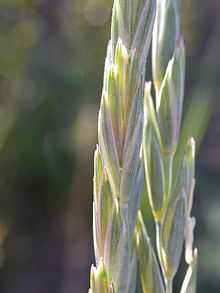Elymus lanceolatus
| Elymus lanceolatus | |
|---|---|
 | |
| Conservation status | |
| Scientific classification | |
| Kingdom: | Plantae |
| (unranked): | Angiosperms |
| (unranked): | Monocots |
| (unranked): | Commelinids |
| Order: | Poales |
| Family: | Poaceae |
| Genus: | Elymus |
| Species: | E. lanceolatus |
| Binomial name | |
| Elymus lanceolatus (Scribn. & J.G.Sm.) Gould | |
| Synonyms | |
|
Agropyron dasystachyum | |
Elymus lanceolatus is a species of grass known by the common names thickspike wheatgrass and streamside wheatgrass. It is native to North America, where it is widespread and abundant in much of Canada and the western and central United States. There are two subspecies, ssp. lanceolatus occurring throughout the species' range and ssp. psammophilus occurring in the Great Lakes region.[1]
This grass produces hollow, erect stems up to 1.3 metres (4.3 feet) tall. The grass grows from a dense network of roots and rhizomes thickly intertwined to form a sod. The leaves are up to 25 centimetres (9.8 inches) long and .5 cm (0.20 in) wide and are flat or slightly rolled at the edges. In dry, hot weather the leaves roll completely into cylindrical shapes. The inflorescence is a narrow, compact spike at the top of the stem, measuring up to 22 cm (8.7 in) long. Each spikelet may have 2 to 11 flowers. The plant reproduces often by seed but in some areas, particularly in sandy substrates, it reproduces vegetatively by sprouting from its rhizome. New plants sprout from a soil seed bank, the seeds surviving in the soil for 3 to 4 years on average. The plant thrives under irrigation or in areas with 200-500 millimeters (8-20 inches) of annual precipitation.[1]
This grass is common and dominant in a number of habitat types in all stages of ecological succession. It can be found in forests, woodlands, sagebrush, shrubsteppe, desert, sandy lakeshores and sand dunes, and a wide variety of grassland and prairie ecosystems. It takes hold easily in disturbed areas such as roadsides. Though it rarely forms large monotypic stands, small pure stands of the species are common. It is highly drought-resistant and tolerant of wildfire and grazing pressure.[1]
This grass makes a good forage for livestock, particularly when it is young and succulent. Wildlife such as elk also consume it. It is valuable for revegetation efforts in disturbed spaces such as pipeline construction sites and is good for rangeland rehabilitation. It is also used in urban ares. Its ability to form thick sod makes it good for erosion control, and the sod is so dense that many weeds are unable to invade stands of it. A number of cultivars have been introduced, such as 'Bannock,' 'Critana,' 'Elbee,' 'Schwendimar,' 'Secar,' and 'Sodar'. The grass, including its cultivars, has been shown to be effective at inhibiting the spread of weeds such as Russian knapweed (Acroptilon repens) and diffuse knapweed (Centaurea diffusa).[1]
This species can hybridize with some other wheatgrasses, such as bluebunch wheatgrass (Pseudoroegneria spicata) and slender wheatgrass (Elymus trachycaulus).[1]
References
Further reading
- Humphrey, L. D. and D. A. Pyke. (2001). Ramet spacing of Elymus lanceolatus (thickspike wheatgrass) in response to neighbour density. Can J Bot 79 1122-26.
- Nowak, R. S., et al. (1993). Differential responses to nitrogen form and concentration for Oryzopsis hymenoides and Elymus lanceolatus. Great Basin Naturalist 53(3) 222-36.
